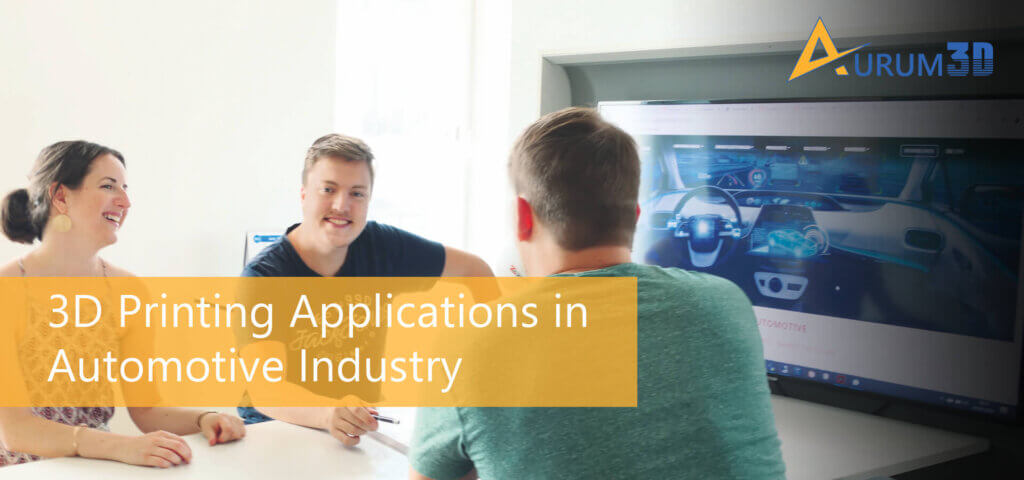The number of electric cars and self-driving cars on the road has been increasing consistently. But many automotive manufactures find it challenging to manufacture the next-generation vehicles. They have to allow designers to experiment with multiple versions of the same automobile component to deliver a superior driving experience. Also, they need to evaluate the functionality and performance of each automobile component quickly and continuously.
The 3D printing technologies have already transformed the automotive industry by revamping both prototyping and manufacturing processes. Automotive manufacturers can avail of 3D printing services and solutions to reduce turnaround time across the manufacturing workflow. In addition to reducing material consumption and wastage, 3D printing technologies enable manufactures to make changes to model or component on demand.
That is why; several market research studies suggest that 3D printing applications in the automotive market will grow steadily over the next few years.
According to Global Market Insights,
“3D Printing in Automotive Market size was estimated to be over USD 1.4 billion in 2017 with the annual sales of over 110 thousand 3D printers. The market is anticipated to grow at a CAGR of more than 25% over the forecast time span (2018-2024).”
The 3D printing use cases or applications vary across auto manufacturers. Some automakers leverage 3D printing technology to produce components and tooling, while others have revealed their plan to launch 3D printed cars in near future. That is why; we can assess the impact of 3D printing products and services on the automotive industry based on these interesting and innovative use cases.
9 Innovative 3D Printing Applications in the Automotive Industry
Scaling up Miniature Designs
Most auto manufacturers these days use 3D printing technologies to produce miniature vehicle designs during the early stages of production. The miniature vehicle design makes it easier for engineers to evaluate the model in multiple forms. They can further scale up the design after evaluating various forms. The new-age 3D printers help auto manufacturers to scale up the model, produce components, and experiment with multiple material properties.
Rapid and Customized Tooling
In a traditional manufacturing environment, an automaker can build tooling in several months despite deploying extra resources. 3D printing technology enables automakers to build and customize tooling rapidly by eliminating additional steps and curtailing production overheads. The engineers use 3D printers to create multiple versions of the tooling and finalize the optimal design. Also, they can use 3D printing technology to create a production-grade model of optimal design.
Reducing Vehicle Customization Time
The auto manufacturers cannot beat competition without providing customers with multiple customization options. But they have to explore ways to customize the vehicle without incurring a huge cost. 3D printing technologies makes it easier for automakers to reduce both vehicle customization time and cost. The engineers use 3D printers to add new driver-friendly features as well as customizing existing automotive features.
Boosting Performance of Sport Cars
The performance of a sports car determines the outcome of the race on the racing track. The engineers have to experiment with many ideas to optimize the performance of sports cars. They need to stimulate the racing environment by performing wind-tunnel testing repeatedly. 3D printers make it easier for auto manufacturers to perform wind-tunnel testing repeatedly by replicating the race car. The engineers can use 3D printers to design multiple versions of components and tooling to be evaluated during wind-tunnel tests.
Producing Spare Parts for Vintage Models
Often auto manufacturers find it challenging to provide spare parts for vintage, classic, and out-of-production models. They have to incur a huge cost to maintain an inventory of spare parts for vehicles they do not produce any longer. The leading auto manufacturers leverage 3D printing technology to provide spare parts for out-of-production models on demand. 3D printers produce such components from digital files without requiring additional tools or resources. Hence, the automobile manufacturers easily increase customer experience without incurring ongoing storage cost.
3D Printing Vehicles Completely
Many auto manufacturers have launched projects to replace conventional vehicle manufacturing processes with 3D printing technology. They plan to 3D print automotive instead of manufacturing. Many companies have already showcased 3D-printed motorcycles at various events and shows. The 3D-printed vehicles are much lighter than conventional vehicles. Also, they help auto manufacturers to produce electric vehicles with higher energy-efficiency.
Allowing Buyers to Personalize
Many automakers provide customers with options to customize and personalize the vehicle according to their own preferences. For instance, they allow customers to change the look and feel of their vehicle by choosing from panels with varying colors and patterns. The auto manufacturers need several weeks to personalize a vehicle using conventional manufacturing techniques. But they can leverage 3D printing technologies to create personalized car parts in hours.
Keeping Assembly Process Short
The complex components of an automobile consist of a large number of parts. The engineers need to assemble the parts to test the component elaborately. In a conventional manufacturing environment, the assembly process remains long due to the amount of time required to produce individual parts. The 3D printing technologies enable engineers to design complex components with a smaller number of parts. The decrease in the number of parts makes it easier for them to reduce both assembly and testing time.
Simplifying Supply Chain Management
The auto manufacturers cannot maintain operational efficiency without streamlining supply chain management. The leading automakers these days operate with gigantic supply chains. They have to work with thousands of companies to procure automotive components and spare parts. Also, they have to spend huge resources to manage the gigantic supply chains efficiently. The 3D printing technologies enable automakers to produce components and spare parts on demand. Hence, the automakers can easily save resources by reducing the number of suppliers.
3D printing is one of the disruptive technologies that have been transforming the global automotive industry continuously. Many auto manufacturers already use 3D printing for rapid prototyping and tooling. But leading automakers are all set to launch 3D printed cars in the near future. That is why; the number of 3D printing applications in the automotive industry will increase consistently.
We, at Aurum3D, have been working with various automotive companies to create customized 3D printing solutions for them. Check out 3D printing for automotive manufacturing for more details.

